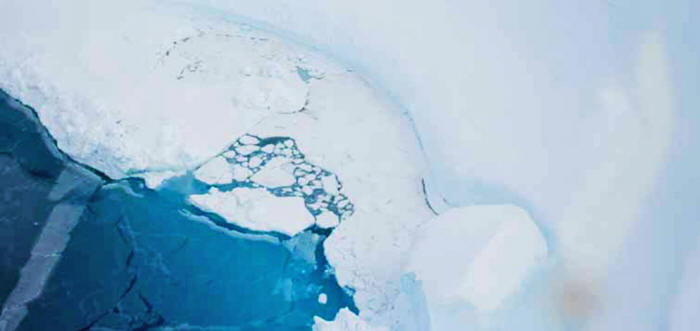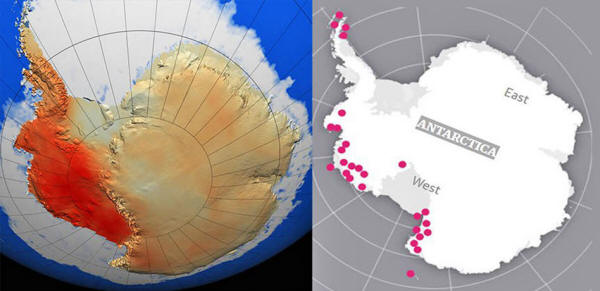|

by Michael Salla
June 28,
2018
from
Exopolitics Website

Source...
A New Volcanic Province - An inventory of Subglacial Volcanoes in
West Antarctica
On June 22, a team of scientists from the University of Rhode Island
and University of East Anglia announced in a paper published in
Nature Communications that they had discovered a new factor in the
rapid melting of Antarctica's
Pine Island Glacier - a previously
unknown active volcano buried deep under the ice.
When combined with
another scientific study released in 2017 by a team of scientists
from the University of Edinburgh, which
announced the existence of 91 volcanoes buried under West
Antarctica's ice sheets in addition to the 41 previously discovered,
a disturbing conclusion is reached.
West Antarctica's
ice sheets are being rapidly melted from a vast network of buried
volcanoes, which are far more active than scientists previously
thought possible.
The June 22 paper,
"Evidence
of an Active Volcanic Heat Source beneath the Pine Island Glacier"
summarized what is currently known of volcanoes that make up the
West Antarctic Rift System (WARS):
To date, as
many as 138 volcanoes have been identified throughout West
Antarctica,
9 including the presently active Mt. Erebus
10 along the Terror Rift, as well as Mt. Siple
10 and Mt. Waesche
11, which both show evidence of recent activity.
However, the
locations and extent of volcanic activity along the WARS are
debated, because many of these 138 known volcano-like features
are buried beneath several kilometers of ice, and some evidence
suggests that much of the interior subglacial WARS is dormant.
-
van Wyk de Vries, M., Bingham,
R. G. & Hein, A. S. A new volcanic province: an inventory of
subglacial volcanoes in West Antarctica. Geol. Soc. Lond.
Spec. Publ. 461 (2017).
-
Rowley, P., Laudon, T., La Prade, K. & LeMasurier, J. in
Volcanoes of the Antarctic Plate and Southern Oceans (eds
LaMasurier, W. E. & Thomson, J. W.) 289–293 (American
Geophysical Union, Washington, 1986).
-
Lough, A. C. et al. Seismic detection of an active
subglacial magmatic complex in Marie Byrd Land, Antarctica.
Nat. Geosci. 6, 1031 (2013).
The assumption
that the majority of West Antarctica's volcanoes are dormant is
increasingly being challenged by new scientific discoveries.
Telltale
signatures of volcanic activity are being found in ocean waters as
evidenced from rare isotopes such as
Helium-3, which was used by the
authors of Pine Island Glacier paper to reach their conclusion.
In addition, heat
increases and seismic activity in Antarctica points to large amounts
of magma moving deep below the West Antarctic Ice Sheets (WAIS), as
the
June 22 paper suggested:
The apparent
surface deformations in the WAIS thickness also suggest
localized heat fluxes that are most likely volcanic due to their
intensity,
14,15
while ash layers from ice cores reveal more recent eruptions.
16
Last, the
detection of earthquakes as recently as 2010 suggest magma
migration beneath the Executive Committee mountains, in a region
of Marie Byrd Land where seismic studies have revealed thin
crust and low-density mantle material beneath.
-
Behrendt, J. C., Finn, C. A., Blankenship, D. D. & Bell, R.
E. Aeromagnetic evidence for a volcanic caldera complex
beneath the divide of the West Antarctic ice sheet. Geophys.
Res. Lett. 25, 4385–4388 (1998).
-
Blankenship, D. D. et al. Active volcanism beneath the West
Antarctic Ice- Sheet and implications for ice-sheet
stability. Nature 361, 526–529 (1993).
-
Iverson, N. A. et al. The first physical evidence of
subglacial volcanism under the West Antarctic Ice Sheet.
Sci. Rep. 7, 11457 (2017).
According to
Professor Karen Heywood, one of the co-authors of the June 22
paper:
The discovery
of volcanoes beneath the Antarctic ice sheet means that there is
an additional source of heat to melt the ice, lubricate its
passage toward the sea, and add to the melting from warm ocean
waters.
It will be
important to include this in our efforts to estimate whether the
Antarctic ice sheet might become unstable and further increase
sea level rise.
While the June 22
paper focused on the impact of the buried volcano melting the Pine
Island Glacier, the wider impact of other buried volcanoes on the
West Antarctic Ice Sheets (WAIS) was briefly
mentioned in the abstract:
Our finding of
a substantial volcanic heat source beneath a major WAIS glacier
highlights the need to understand subglacial volcanism, its
hydrologic interaction with the marine margins, and its
potential role in the future stability of the WAIS.
The new findings
about the influence of one or more active volcanoes to explain the
rapid melting of Pine Island Glacier, along with the temperature
increase and melt-offs observed elsewhere in the frozen continent
all point to powerful transformative events in West Antarctica.
The following
long-term temperature map of Antarctica alongside the newly
discovered volcanoes, shows how and why West Antarctic is heating
far more rapidly than East Antarctica.

Left image shows
temperature increase of Antarctica from 1956-2006
(Credit: NASA/Goddard Space Flight Center Scientific Visualization
Studio);
right image shows
2017 discovery of 90 new volcanoes in Antarctica.
If "global warming"
due to CO2 emissions was the explanation, then warming
oceans would be uniform in heating both East and West Antarctica.
Yet most
scientific data points to West Antarctica melting.
The June 22 paper,
along with other scientific studies provide a cogent explanation for
what is really driving the melting of the West Antarctic ice sheets.
The submerged volcanoes are more active than previously thought and
are melting the ice sheets far more rapidly than scientists believe
possible.
If we take the
upcoming
Solar Cycle 25 (2019 - 2030) as the catalyst for triggering
volcanic activity around the Earth through increased solar activity,
West Antarctica's ice sheets could disappear in as little as a
decade or so.
There are four
major effects that will occur from West Antarctica's ice sheets
disappearing so quickly.
-
First,
ocean levels will rise far more dramatically than previously
thought. If all the ice in West Antarctica were to melt,
ocean levels would rise by 10 feet (3.3 meters).
Rather than
humanity
having centuries to prepare as estimated by many
geologists, it would only have a decade.
-
Second,
whistleblower claims that there are large subterranean
bases in Antarctica that belong to multiple secret space
programs dating back to World War II will be exposed for all
the world to see.
It can be predicted that nations and
corporations managing such classified programs would not
allow themselves to be preempted by geologic events, and
accelerate official disclosure initiatives.
-
Third,
ancient artifacts of a flash frozen advanced civilization
buried under the Antarctic ice will be revealed confirming
rumors and eyewitness accounts of such a discovery going
back to the early 1990's.
The technologies and knowledge
acquired from such discoveries is likely to provide humanity
with rapid scientific revolutions spanning aerospace,
health, archeology and even religion.
-
Finally,
the rapid melt-off of West Antarctic ice will impact the
centrifugal forces driving Earth's axis of rotation, thereby
leading to a possible Pole Shift as discussed by Charles
Hapgood and Albert Einstein in Hapgood's book,
Earth's
Shifting Crust (1958).
Scientific
corroboration of Pine Island Glacier being melted from underneath by
volcanic activity should serve as a warning about the profound
effect of such a phenomenon repeating itself throughout the entire
chain of volcanoes buried deep under West Antarctica, and the
powerful implications this holds for the entire planet...
|



